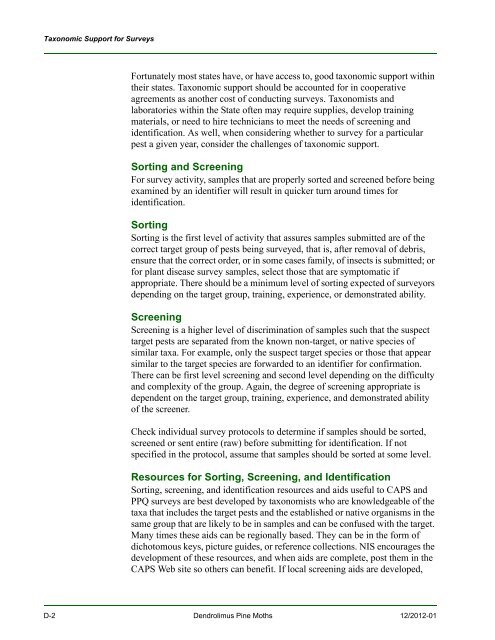New Pest Response Guidelines - aphis - US Department of Agriculture
New Pest Response Guidelines - aphis - US Department of Agriculture
New Pest Response Guidelines - aphis - US Department of Agriculture
Create successful ePaper yourself
Turn your PDF publications into a flip-book with our unique Google optimized e-Paper software.
Taxonomic Support for Surveys<br />
Fortunately most states have, or have access to, good taxonomic support within<br />
their states. Taxonomic support should be accounted for in cooperative<br />
agreements as another cost <strong>of</strong> conducting surveys. Taxonomists and<br />
laboratories within the State <strong>of</strong>ten may require supplies, develop training<br />
materials, or need to hire technicians to meet the needs <strong>of</strong> screening and<br />
identification. As well, when considering whether to survey for a particular<br />
pest a given year, consider the challenges <strong>of</strong> taxonomic support.<br />
Sorting and Screening<br />
For survey activity, samples that are properly sorted and screened before being<br />
examined by an identifier will result in quicker turn around times for<br />
identification.<br />
Sorting<br />
Sorting is the first level <strong>of</strong> activity that assures samples submitted are <strong>of</strong> the<br />
correct target group <strong>of</strong> pests being surveyed, that is, after removal <strong>of</strong> debris,<br />
ensure that the correct order, or in some cases family, <strong>of</strong> insects is submitted; or<br />
for plant disease survey samples, select those that are symptomatic if<br />
appropriate. There should be a minimum level <strong>of</strong> sorting expected <strong>of</strong> surveyors<br />
depending on the target group, training, experience, or demonstrated ability.<br />
Screening<br />
Screening is a higher level <strong>of</strong> discrimination <strong>of</strong> samples such that the suspect<br />
target pests are separated from the known non-target, or native species <strong>of</strong><br />
similar taxa. For example, only the suspect target species or those that appear<br />
similar to the target species are forwarded to an identifier for confirmation.<br />
There can be first level screening and second level depending on the difficulty<br />
and complexity <strong>of</strong> the group. Again, the degree <strong>of</strong> screening appropriate is<br />
dependent on the target group, training, experience, and demonstrated ability<br />
<strong>of</strong> the screener.<br />
Check individual survey protocols to determine if samples should be sorted,<br />
screened or sent entire (raw) before submitting for identification. If not<br />
specified in the protocol, assume that samples should be sorted at some level.<br />
Resources for Sorting, Screening, and Identification<br />
Sorting, screening, and identification resources and aids useful to CAPS and<br />
PPQ surveys are best developed by taxonomists who are knowledgeable <strong>of</strong> the<br />
taxa that includes the target pests and the established or native organisms in the<br />
same group that are likely to be in samples and can be confused with the target.<br />
Many times these aids can be regionally based. They can be in the form <strong>of</strong><br />
dichotomous keys, picture guides, or reference collections. NIS encourages the<br />
development <strong>of</strong> these resources, and when aids are complete, post them in the<br />
CAPS Web site so others can benefit. If local screening aids are developed,<br />
D-2 Dendrolimus Pine Moths 12/2012-01

















